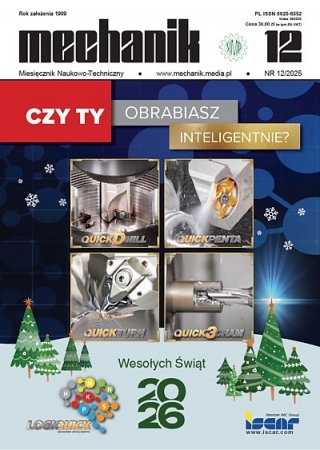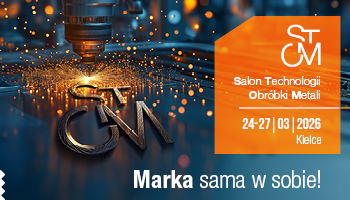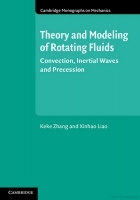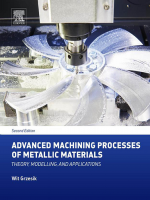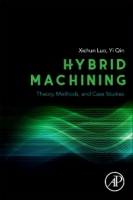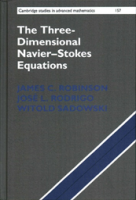Evaluation of the cutting insert condition influence on the microstructure of surface layer after turning of Inconel 718 alloy *
Ocena wpływu stanu ostrza na mikrostrukturę warstwy wierzchniej po toczeniu stopu Inconel 718
Author: Piotr Szablewski, Tadeusz Chwalczuk, Tomasz Dobrowolski
Mechanik nr 12/2019 - Narzędzia
ABSTRACT: Research concerns the evaluation of the cutting insert condition on the microstructure of the surface layer after longitudinal turning of Inconel 718 alloy using carbide inserts. Value of the VBC wear index after dry machining with variable feed f and depth of cut ap was evaluated. White layer was observed up to 2,5 μm.
KEYWORDS: Inconel 718, white layer, inserts wear
STRESZCZENIE: Badano wpływ stanu ostrza na mikrostrukturę technologicznej warstwy wierzchniej po toczeniu wzdłużnym stopu Inconel 718 ostrzami węglikowymi. Oceniano wartość wskaźnika zużycia VBC po toczeniu na sucho ze zmiennymi parametrami posuwu f oraz głębokości skrawania ap. Zaobserwowano obecność białej warstwy na głębokości do 2,5 μm.
SŁOWA KLUCZOWE: Inconel 718, biała warstwa, zużycie ostrza
BIBLIOGRAFIA / BIBLIOGRAPHY:
[1] Leshock C.E., Kim J.N., Shin Y.C. “Plasma enhanced machining of Inconel 718: modeling of workpiece temperature with plasma heating and experimental results”. International Journal of Machine Tools & Manufacture. 41 (2001): 877–897, https://doi.org/10.1016/S0890-6955(00)00106-1.
[2] Nalbant M., Altin A., Gökaya H. “The effect of cutting speed and cutting tool geometry on machinability properties of nikel-base Inconel 718 super alloys”. Materials & Design. 28 (2007): 1334–1338, https://doi.org/10.1016/j.matdes.2005.12.008.
[3] Szablewski P., Chwalczuk T. „Ocena morfologii powierzchni obrobionej stopu Inconel 718 po toczeniu wzdłużnym”. Zeszyty Naukowe Politechniki Rzeszowskiej, 295, Mechanika 89, RUTMech. XXXIV, 89, 3/17 (lipiec–wrzesień 2017): 379–384, https://doi.org/10.7862/rm.2017.34.
[4] Bushlya V., Zhou J.M., Lenrick F., Avdovic P., Stål J.-E. “Characterization of White Layer Generated when Turning Aged Inconel 718”. 1st CIRP Conference on Surface Integrity (CSI), Procedia Engineering 19, (2011): 60–66, https://doi.org/10.1016/j.proeng.2011.11.080.
[5] Bosheh S.S., Mativenga P.T. „White layer formation in hard turning of H13 tool steel at high cutting speeds using CBN tooling”. International Journal of Machine Tools & Manufacture. 46 (2006): 225–233, https://doi.org/10.1016/j.ijmachtools.2005.04.009.
[6] Sharman A.R.C., Hughes J.I., Ridgway K. “The effect of tool nose radius on surface integrity and residual stresses when turning Inconel 718TM”. Journal of Materials Processing Technology. 216 (2015): 123–132, https://doi.org/10.1016/j.jmatprotec.2014.09.002.
[7] Jafarian F., Amirabadi H., Sadri J. „Experimental measurement and optimization of tensile residual stress in turning process of Inconel 718 superalloy”. Measurement. 63 (2015): 1–10. https://doi.org/10.1007/s00170-016-9737-3.
[8] Dudzinski D., Devillez A., Moufki A., Larrouqiere D., Verrouki V., Vigneau J. „A review of developments towards dry and high speed machining of Inconel 718 alloy”. International Journal of Machine Tools & Manufacture. 44, (2004): 439–456, https://doi.org/10.1007/s00170-016-9737-3.
[9] Mohsan A.U.H., Zhanqiang L., Padhy K.G. „A review on the progress towards improvement in surface integrity of Inconel 718”. International Journal of Advanced Manufacturing Technology. 91, 1–4 (2017): https://doi.org/107–125, 10.1007/s00170-016-9737-3.
[10] Axinte D.A., Andrews P., Li W., Gindy N., Withers P.J. „Turning of advanced Ni based alloys obtained via powder metallurgy router”. Annals of the CIRP. 55/1 (2006): 117–120, https://doi.org/10.1016/S0007-8506(07)60379-5.
DOI: https://doi.org/10.17814/mechanik.2019.12.111
* Artykuł recenzowany



